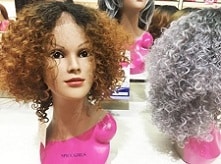Artificial or false hair is called a wig . It can be made with hair and is usually used to hide baldness , although there are other reasons.
It must be stated that there are different theories about the etymological origin of the term wig. However, the one that gains the most strength is the one that establishes that it derives from the French “perruque.” This word, in turn, comes from the Latin “pilus”, which can be translated as “hair”.
 When someone loses their hair as a result of alopecia , an illness, or another type of medical problem, they may want to disguise their lack of hair with a wig. In these cases, we want the wig to be as natural as possible.
When someone loses their hair as a result of alopecia , an illness, or another type of medical problem, they may want to disguise their lack of hair with a wig. In these cases, we want the wig to be as natural as possible.
Wigs can also be used for ritual or ceremonial purposes . In some countries , judges wear wigs as a symbol of their status.
It is common, on the other hand, for people to use wigs at costume parties . This type of wig is not intended to imitate the appearance of hair, but quite the opposite: it stands out for its bright colors and format. Anyone who wants to attract attention at a celebration, in this context, can wear a blue wig or a green wig , to mention two possibilities.
For actors and actresses, wigs are very important elements when it comes to characterization . These items can be used to appear older or younger , or to achieve a physical resemblance to the person whom one intends to embody.
Suppose that a bald actor must play Axl Rose in a film, the Guns N' Roses singer who always sported a long hair. For this role, the protagonist of the film will need to wear a red wig that imitates Rose 's hair, in addition to using makeup and other resources that give verisimilitude to his performance.
In addition to everything stated above, it must be emphasized that there are different types of wigs. However, among the most significant there are two: natural wigs, which, as their name indicates, are made with human hair and synthetic wigs. These, for their part, are those that are made with synthetic fibers and using standard manufacturing molds.
Many people prefer to use natural wigs, although they have a higher price than synthetic ones. This is because the former bring with them advantages such as the following:
-They have a much less artificial appearance.
-They have higher quality.
-In the same way, it must be emphasized that they have greater durability.
However, those who opt for synthetic ones do so because they have in their favor that they are cheaper and require easier maintenance. In the same way, it should not be overlooked that they do not need to be moisturized periodically and that they are very easy to comb.
Likewise, within the natural wigs and those made of synthetic fibers we find other models: straight wigs, curly wigs, short wigs, medium-length wigs, long wigs... Not to mention that they can then be found in different colors.
